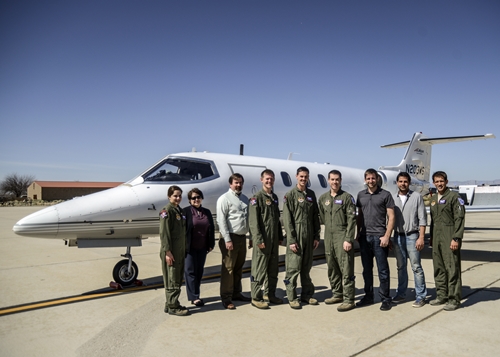
Students and professors from the USAF Test Pilot School and University of Illinois. Naira Hovakimyan is second from the left. (Rebecca Amber, USAF)
20 March 2015. U.S. Air Force pilots tested a new flight control system designed by engineers at University of Illinois that automatically adapts aircraft to changing conditions faster than most human pilots can respond. The L1 adaptive control system is a product of the university’s Advanced Control Research Laboratory in Urbana, Illinois led by mechanical engineering professor Naira Hovakimyan.
A start-up company, Intelinair in San Jose, California, already licensed Hovakimyan’s technology from the university for control systems in unmanned aircraft used in research and agriculture.
Hovakimyan and colleagues are seeking a technology that provides an extra measure of safety for piloted aircraft, despite the excellent safety record of commercial aviation. “The flight control systems on today’s commercial aircraft have been tested and matured for decades and are considered very safe for the millions of passengers traveling on airplanes every day,” says Hovakimyan in a university statement. “But despite their safety, there is still great need for new technologies that could prevent more accidents.”
The L1 adaptive contol system aims to quickly respond to changing flight dynamics by separating adaption calculations from the robustness of the response needed to bring the aircraft under control. L1’s algorithms compute changes in the aircraft’s current status, but also calculate uncertainties in those conditions. Those calculations define the feedback loop that includes limitations placed on the robustness of a corrective response. This structure in the system, say its developers, makes it possible to detect changes in flight dynamics and quickly adapt to conditions safely, within the calculated boundaries.
In a project that ended in 2010, NASA asked a number of research groups to develop flight control systems, which the agency tested in small-scale aircraft. The lab says only 9 of the systems submitted to NASA qualified for flight testing, and L1 was the only system to provide consistent and reliable responses, including in stalls and post-stall conditions.
In early March, Hovakimyan’s lab flight-tested the L1 system for the first time at the Air Force’s Test Pilot School at Edwards Air Force Base in California, in a Calspan Learjet configured for evaluating new control systems. It was the first flight test for L1, and included pilots of F-16 fighters and B-52 bombers. The tests aimed to evaluate L1’s ability to control routine aircraft handling, and respond as well to abrupt hazardous in-flight conditions.
Among the hazardous failure conditions tested were changes in aerodynamics and a shift in the aircraft’s center of gravity, where pilots can sometimes overcompensate in their response, causing an even more dangerous situation. In all of the failure condition tests, say the researchers, the L1 system was able to safely respond to the problem and restore predictable and consistent performance. The test pilots later successfully performed eight touch-and-go landings of the L1 system, both in routine and failure conditions.
Hovakimyan would like to see L1 technology adopted by major airlines as a backup control system for their trained pilots. “If anything goes wrong, this would kick in,” she adds. “If there’s one switch that a pilot can turn on when the aircraft is in trouble, I want to see that happen.”
The following video from the Learjet cockpit shows test pilots engaging the L1 system under failure conditions.
- XPrize Awards $5.25M for Lunar Technologies
- Student Project Aims to Land Time Capsule on Mars
- Planet Labs Launches Two More Earth Imaging Satellites
- Radiation Sensors Launched in Open-Source Satellites
- Non-Battery Power Supply for Aircraft Sensors Flight Tested
* * *

 RSS - Posts
RSS - Posts
You must be logged in to post a comment.